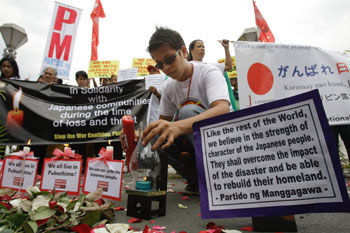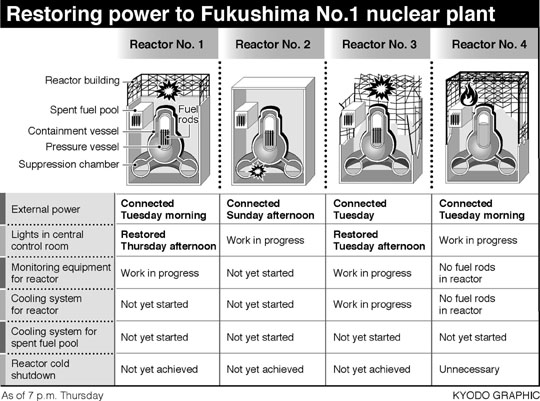A former acting head of the Atomic Energy Commission called Thursday for the government to tell the public how radioactive emissions have spread from the Fukushima No. 1 nuclear power plant in the past and to predict future radiation exposure risks according to distance for the most critical scenarios.
In a telephone interview with The Japan Times, Shunichi Tanaka, former acting chairman of the commission, said it was irresponsible for the government to force people to evacuate their homes without disclosing concrete data on the calculated exposure risks they face from wind-borne radioactive materials.
"The government has not yet said in concrete terms why evacuation is necessary to the people who have evacuated," he said.
The AEC is an independent entity that sets the nation's basic policies on development and use of nuclear power.
Tanaka said Wednesday's public release of past radiation exposure risks as calculated by the Nuclear Safety Commission was a positive step toward informing the public.
The NSC, an independent entity, sets the nuclear safety policy for the nation from a neutral standpoint and gives guidance to ministries and the power industry.

Tanaka organized and led an operation there to halt the runaway chain reaction and put an end to the incident, which highlighted the serious lack of training and oversight in the nuclear power industry.
In Fukushima, the government has evacuated residents within 20 km of the power plant and told those between 20 km to 30 km from it to stay indoors until the situation is confirmed safe. The United States warned U.S. citizens within 80 km to clear out.
Nuclear experts have called on the government to publicize detailed data on past and predicted atmospheric dispersions of radioactive materials from the plant, which is run by Tokyo Electric Power Co. But the government at first declined and said such data were unreliable.
Tanaka said the government's attitude was wrong because dispersion data are calculated on the basis of real conditions, including weather. Unrealistic hypotheses are not being used to predict dispersions, he added.
Repeating what he said at a March 18 meeting of the Science Council of Japan, which answers to the prime minister, Tanaka said the government should publicize all related data it has on calculations made by SPEEDI, a computer simulation system set up by the Nuclear Safety Technology Center to determine or predict dispersions of radioactive substances released by a nuclear accident.
SPEEDI - short for System for Prediction of Environmental Emergency Dose Information - is the same system the NSC used to make its risk calculations. It divides the nation into a fine geographic grid of 250 × 250-meter squares to predict how radioactive substances spread.
He said the government should use SPEEDI to tell the public: 1) what the geographical distribution of nuclear substances released by Fukushima No. 1 has been, along with the radiation levels. 2) what the distribution of radioactive substances and radiation levels might be if the situation there gets further out of hand.
Tanaka said making this data public will help the public realize the need to evacuate.
In the worst-case scenario for a reactor, the containment vessel will fail and the fuel rods will combust, releasing large amounts of radioactive materials into the atmosphere.
In the worst-case scenario for a pool of spent fuel rods, the same thing will happen if the cooling water they are kept in evaporates and is not replaced. The pool is outside the reactor and have no containment vessel.
Tanaka said preventing hydrogen explosions from occurring in the containment vessels and preventing water from running out in the spent fuel storage pools are both crucial.
Hydrogen emerges when the fuel rods are so hot that their zirconium cladding starts burning and reacting with the water in the pressure vessel. The accumulated hydrogen can ignite when it comes into contact with oxygen.
He said the situation at Fukushima No. 1 is so serious that it is imperative for the government to bring all of Japan's knowledge and wisdom to bear on the crisis because Tepco and the Nuclear and Industrial Safety Agency are outmatched.
He said a system should be set up that allows Tepco, all the nation's nuclear-related authorities and universities to work together to end the crisis.
Japan should also not hesitate to cooperate with the U.S. Nuclear Regulatory Commission, as it has been doing for the past week, he added.




Reader Comments
to our Newsletter